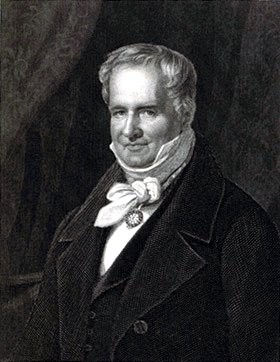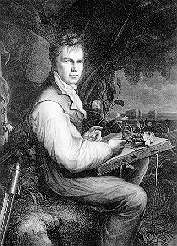Baron Von Humboldt
For a Spanish language version of this episode, Click Here.
Today, a nearly forgotten hero. The University of Houston's College of Engineering presents this series about the machines that make our civilization run, and the people whose ingenuity created them.
Checking out an armload of books made me late for supper the other day. You see, none of them had been used since the 1960s. The librarian had to glue bar codes into each one.
These books were all by Baron Alexander von Humboldt, and they were only a fraction of his output. The naturalist von Humboldt, born in Germany in 1769, was one of best-known scientists of his age. Now his works languish, unread, on library shelves.
Von Humboldt began writing when he was 21 and he was 60 when he explored the far reaches of Siberia. But he began his greatest trip when he was 30. He, and a French botanist named Bonpland, set off to explore Meso-America. The first great leg of that trip began in Venezuela. They explored the Orinoco River and showed that it connected, through the Rio Negro, to the Amazon. They traveled 6400 miles through sweltering, mosquito-infested swamps and jungles, in small hand-paddled boats.
After organizing their notes and specimens in Cuba, they went up the Magdalena River in Colombia and over the Andes on foot to Lima, Peru. They climbed within 1400 feet of the summit of Chimbarozo, then the tallest known mountain -- 21½ thousand feet high. For 36 years Humboldt and Bonpland were the two people who'd risen furthest from sea level. French balloonists never made it that high because they couldn't handle the lack of oxygen.
From 1799 to 1804 they mapped Mexico, Central America, and much of South America. They collected material to fill scores of books in years to come -- plants, animals, geography, and geology. Their maps weren't superseded for years. When Humboldt noted how the Pacific Ocean runs north along the coast of Peru, that flow was called the Humboldt Current, even though he disclaimed the credit.
On his way home, Humboldt stopped in Washington, DC, to visit a kindred soul -- President Thomas Jefferson. Jefferson entertained him for weeks and picked his brain. A year before, Jefferson had made the Louisiana Purchase and, just as Humboldt arrived, he was sending Lewis and Clark out to explore it. But their trip was modest alongside von Humboldt's and Bonpland's Odyssey.
Back in Europe, Humboldt became the reigning scientific statesman and voice for humanitarian use of the New World. He told Europe her "unhappy slaves" were quite "capable of becoming farmers and land holders." He tried to create a unification of the sciences in his five-volume series, Kosmos. But, in the end, he left no Theory of Evolution or Relativity. His real genius was an uncanny ability to look at a strange land and see what made it tick.
Today, von Humboldt's name is attached to a river in Nevada, towns in Nebraska, Saskatchewan, Tennessee -- to elements of geography all over America. So we still say the name, even as we forget this person who opened new worlds to us.
I'm John Lienhard, at the University of Houston, where we're interested in the way inventive minds work.
(Tema musical)
McCullough, D., Brave Companions: Portraits in History. New York: Touchstone, 1992, Chapter One.
While McCullough provides us with a fine introduction to Baron Alexander von Humboldt and a fine indication of his role in early nineteenth-century natural science, it is a short introduction. Most encyclopedias give good coverage to von Humboldt. And then, too, your library's catalog (like mine) will yield many items when you search under his name in the author index.
See also, http://en.wikipedia.org/wiki/Alexander_von_Humboldt

Baron Alexander von Humboldt
19th century engraving courtesy of Special Collections, UH Library

This image is of a younger von Humboldt